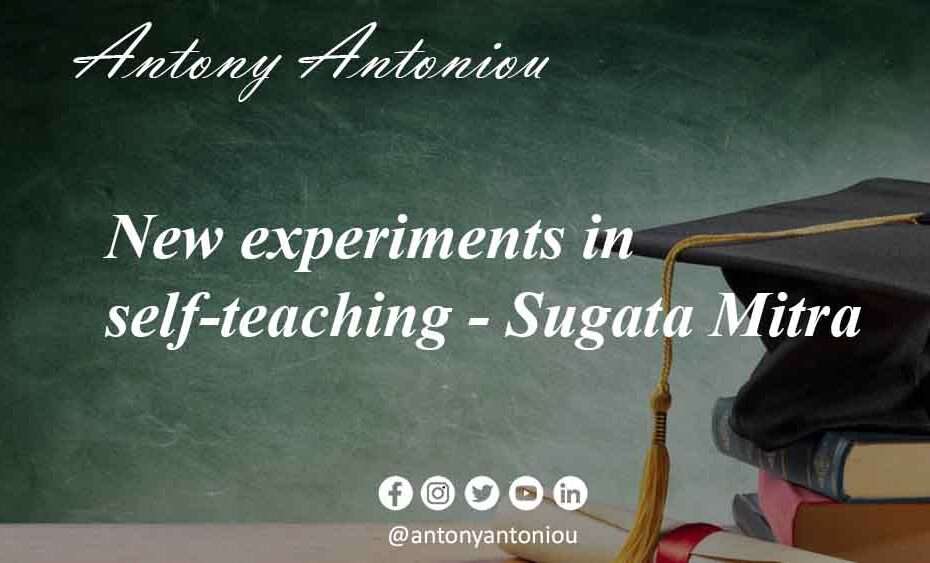New experiments in self-teaching – Sugata Mitra
Background
Around 12 years ago, Sugata Mitra embarked on a journey to address a critical issue prevalent in developing countries – the lack of access to good teachers. He noticed that there were many remote places worldwide where qualified educators were reluctant to go, leaving children without the quality education they needed the most. However, through a series of groundbreaking experiments and a belief in the innate curiosity of children, Mitra discovered a revolutionary approach to learning that could transform education as we know it.
I have always been an advocate of experiential learning, for me, the notion of sitting in a classroom being spoken at is anathema, especially for the active mind that invariably struggles to maintain attention.
However, in the modern day, the active, creative or free thinking mind, mainstream education is a poison chalice, that can hinder their learning, instead of enhancing it. Any child who does not fit in to the ‘Robot behaviour’ that is the norm, is so easily diagnosed as ADHD and then pumped with Ritalin, which is criminal. Now, with the move to ‘Academies’ education is becoming the servant of the corporations, inhibiting free thinking and focusing on creating ‘worker Ants’ for the future.
I came across this man a few years ago, and I was really impressed by his experiment, but not surprised by the results. On a personal level, I was one of the children who could not maintain attention at school, I could not focus, I lost interest and was easily distracted or bored. It was not until years later, when I went to University as a mature student that I realised it was not me, it was in fact the teaching methods in schools.
After completing my business studies, I was privileged to have been offered a place on a pioneering ‘Action Learning Master’s Degree, this was based on discussion, experiential learning, and interaction. This was the most progressive education period I have ever experienced and it confirmed my thoughts on learning styles.
Background
Around 12 years ago, Sugata Mitra embarked on a journey to address a critical issue prevalent in developing countries – the lack of access to good teachers. He noticed that there were many remote places worldwide where qualified educators were reluctant to go, leaving children without the quality education they needed the most. However, through a series of groundbreaking experiments and a belief in the innate curiosity of children, Mitra discovered a revolutionary approach to learning that could transform education as we know it.
The Hole in the Wall Experiment
In 1999, Mitra initiated his first experiment in a New Delhi slum. He embedded a computer with high-speed internet into a wall and left it there for the children to explore on their own. Despite having little exposure to formal education and technology, the children surprised everyone by quickly learning to use the computer and the internet independently. From browsing to recording music and even capturing pictures, they demonstrated an incredible ability to learn what they were interested in without any formal instruction.
The Power of Self-Organized Learning
Mitra’s experiments expanded across India and other parts of the world, revealing that groups of children could master computer and internet skills without explicit guidance. He observed children learning complex topics, such as biotechnology, on their own using online resources. Through group collaboration and collective curiosity, children were able to achieve educational objectives and develop a deep understanding of various subjects.
Breaking Language Barriers
In a remarkable incident, Mitra discovered that children with strong regional accents taught themselves to speak English with a neutral British accent by using speech-to-text interfaces on computers. This finding showed the power of interest-driven learning and the potential for technology to transcend language barriers and bridge educational gaps.
The Role of the Granny Cloud
To further support self-organized learning, Mitra introduced the concept of the “granny cloud.” Grandmothers from various locations volunteered to provide an hour of broadband connection each week, acting as virtual mentors for the children through Skype. These enthusiastic mentors offered encouragement and admiration, creating a nurturing environment where the children thrived in their quest for knowledge.
Self-Organized Learning Environments (SOLEs)
Building on his findings, Mitra developed Self-Organized Learning Environments (SOLEs). These environments consist of groups of children collaborating around computers and big screens, engaging in inquiry-based learning. Mediators, often remote educators from various locations, facilitate learning experiences when necessary, but the focus remains on self-directed learning.
The Future of Education: A Self-Organizing System
Mitra believes that education is a self-organizing system, where learning emerges naturally when children are allowed to explore topics that genuinely interest them. While more research is needed to prove this hypothesis, Mitra’s vision for the future of education is bold and inspiring.
Transforming Education Globally
Mitra envisions a future where one billion children have access to 100 million mediators and 10 million SOLEs, with a budget of 180 billion dollars over ten years. This ambitious initiative has the potential to transform education globally and equip children with the skills and knowledge needed to thrive in an ever-changing world.
Conclusion
Sugata Mitra’s groundbreaking experiments demonstrate the power of self-organized learning and the boundless potential of curious minds. By leveraging technology and fostering collaborative environments, we can unleash the true potential of education and empower children worldwide to become lifelong learners and critical thinkers. As we work towards building a self-organizing education system, we must embrace curiosity, encourage exploration, and harness the innate desire to learn that lies within every child. Together, we can shape a brighter future for generations to come.
Read more about my thoughts on interactive/action learning HERE:

